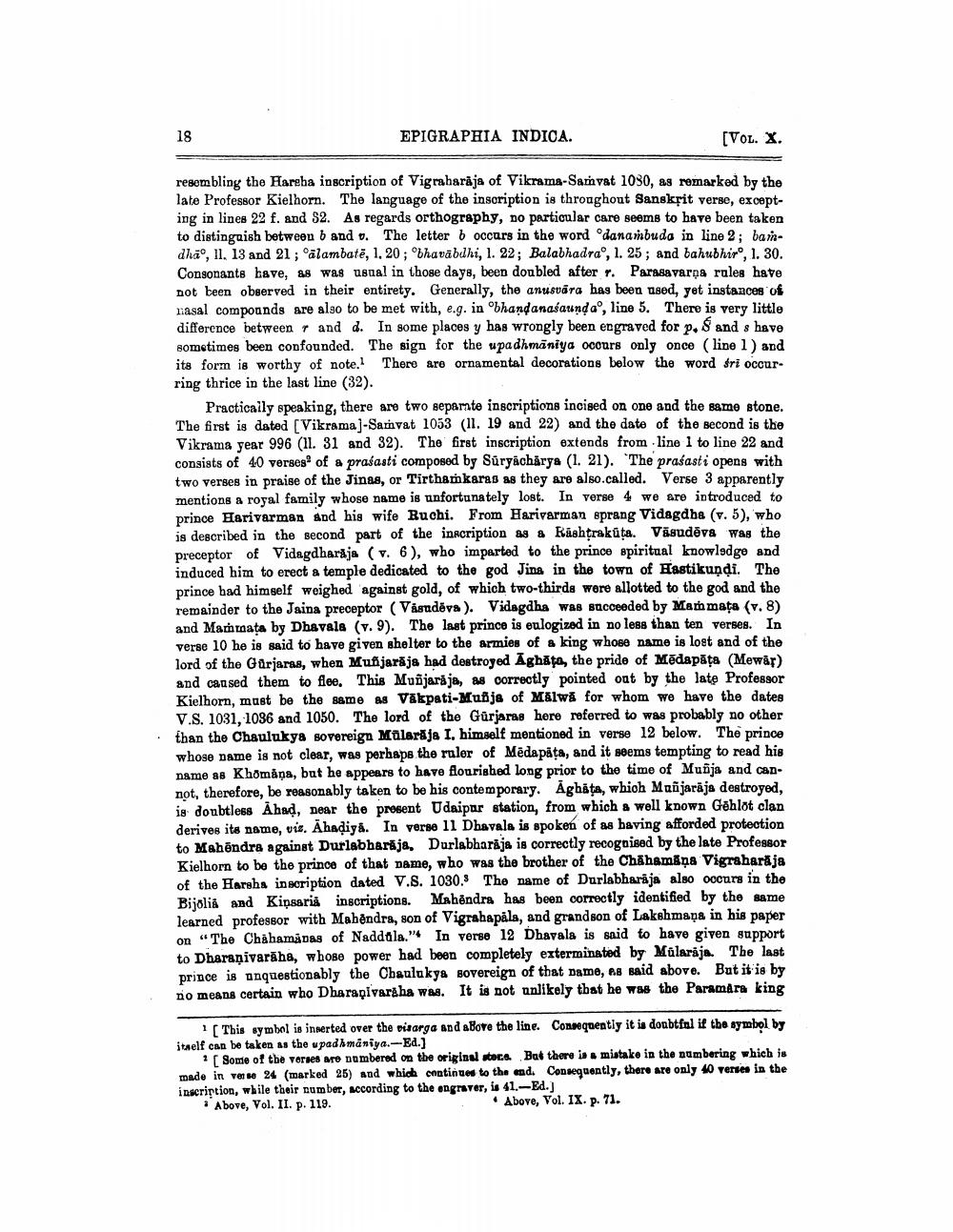________________
18
EPIGRAPHIA INDICA.
[VOL. X.
resembling the Hareha inscription of Vigraharaja of Vikrama-Samvat 1080, as remarked by the late Professor Kielhor. The language of the inscription is throughout Sanskrit verse, excepting in lines 22 f. and S2. As regards orthography, no particular care seems to have been taken to distinguish between b and . The letter b occurs in the word danambuda in line 2; banadha, 11, 13 and 21 ; Calambatē, 1. 20; bhavabdhi, 1. 22; Balabhadra', 1. 25; and bahubhiro, 1. 30. Consonants have, ss was usual in those days, been doubled after . Paragavarna rules have not been observed in their entirety. Generally, the anusvára has been used, yet instances of rasal compounds are also to be met with, e.g. in obhandanasaund a", line 5. There is very little difference between and d. In some places y has wrongly been engraved for p. 8 and s have sometimes been confounded. The sign for the upadhmaniya occurs only once (line 1) and its form is worthy of note. There are ornamental decorations below the word tri occur. ring thrice in the last line (32).
Practically speaking, there are two sepamte inscriptions incised on one and the same stone. The first is dated (Vikramaj-Samvat 1053 (11. 19 and 22) and the date of the second is the Vikrama year 996 (11. 31 and 32). The first inscription extends from line 1 to line 22 and consists of 40 verses of a prasasti composed by Suryachårya (1. 21). "The prasasti opens with two verses in praise of the Jings, or Tirthamkaras as they are also called. Verse 3 apparently mentions a royal family whose name is unfortanately lost. In verse 4 we are introduced to prince Harivarman and his wife Ruchi. From Harivarman sprang Vidagdbe (v. 5), who is described in the second part of the inscription as & Kashtrakata. Vänudēva was the preceptor of Vidagdharaja ( v. 6), who imparted to the prince spiritual knowledge and induced him to erect a temple dedicated to the god Jina in the town of Hastikundi. The prince had himself weighed against gold, of which two-thirds were allotted to the god and the remainder to the Jaina preceptor (Vásudova). Vidagdha was succeeded by Mammata (v. 8) and Mam mata by Dhavala (v. 9). The last prince is eulogized in no less than ten verses. In verse 10 he is said to have given shelter to the armies of a king whose name is loet and of the lord of the Gurjaras, when Muñjarăja had destroyed Aghāta, the pride of Mēdapăța (Mewar) and can sed them to floe. This Muñjaraja, as correctly pointed out by the late Professor Kielhorn, must be the same as Vakpati-Muñja of Malwă for whom we have the dates V.S. 1031, 1036 and 1050. The lord of the Gurjaras here referred to was probably no other than the Chaulukys sovereign Mülarāja I. himself mentioned in verse 12 below. The prince whose name is not clear, was perhaps the ruler of Mēdapata, and it seems tempting to read his name as Khomåņa, but he appears to have flourished long prior to the time of Muñja and cannot, therefore, be reasonably taken to be his contemporary. Aghata, which Mañjaräja destroyed, is donbtless Ahad, near the prosent Udaipar station, from which a well known Gahlot clan derives its name, viz. Ahadiya. In verse 11 Dhavala is spoken of as having afforded protection to Mahēndra against Durlabharija, Durlabharaja is correctly recognised by the late Professor Kielhorn to be the prince of that name, who was the brother of the Chāham na Vigraharaja of the Harsha inscription dated V.8. 1030. The name of Durlabharāja also occurs in the Bijolia and Kipsaria inscriptions. Mahendra has been correctly identified by the same learned professor with Mahendra, son of Vigrahapala, and grandson of Lakshmaņa in his paper on "The Chahamadas of Naddila." In verse 12 Dhavala is said to have given support to Dharanivaräha, whose power had been completely exterminated by Mularaja. The last prince is unquestionably the Chaulukya sovereign of that dame, A8 said above. But it is by no means certain who Dharapivaráha was. It is not unlikely that he was the Paramāra king
[This symbol is inserted over the pisarga and a Bore the line. Consequently it is doubtful if the symbol by ituelf can be taken as the upadhmaniya.--Ed.)
1 [ Some of the verses are numbered on the original store. But there is . mistake in the numbering which is made in vene 24 (marked 25) and which continues to the end. Consequently, there are only 10 verses in the inscription, while their cumber, according to the engraver, is 41.--Ed.) * Above, Vol. II. p. 119.
• Above, Vol. IX. p. 71.




